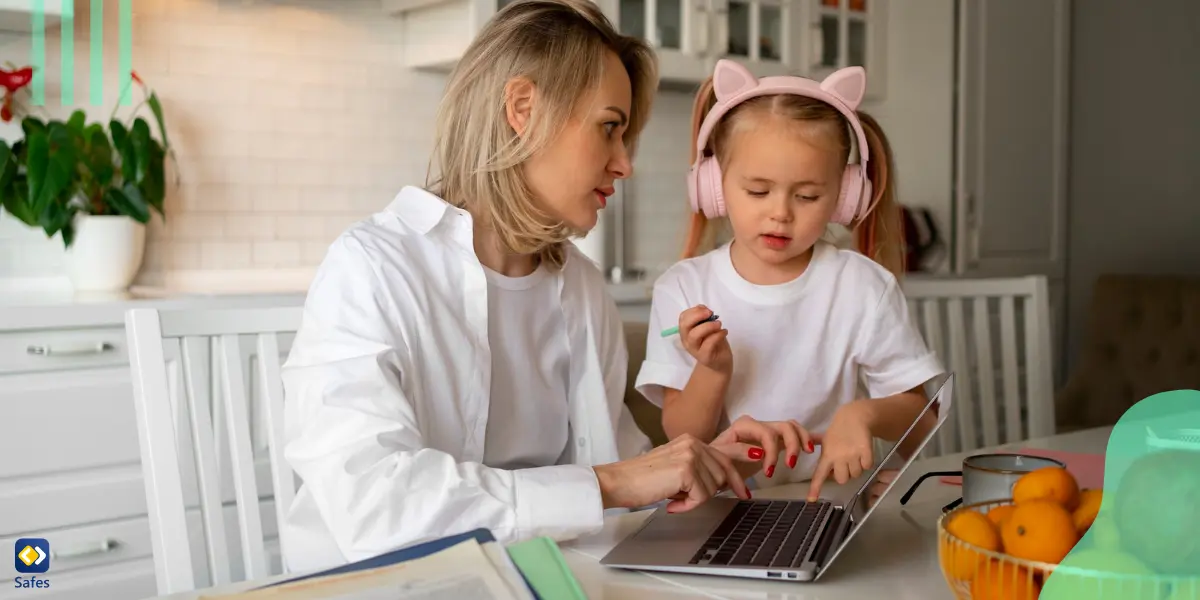More than any other era in history, nowadays children are growing up surrounded by screens and digital devices. From smartphones and tablets to computers and video game consoles, technology is an inseparable part of their daily lives. But just like we teach them to eat their fruits and veggies for physical health, it’s equally important to monitor their digital nutrition.
Download and Start Your Free Trial of the Safes Parental Control App
Here, you will explore this concept and learn practical tips on how to cultivate healthy digital habits for kids. So, let’s start with the definition of this solution to better guide our children to use their digital devices wisely and responsibly.
What Is the Meaning of Digital Nutrition?
Similar to physical nutrition, digital nutrition refers to our consumption of digital content and experiences. Just as we nourish our bodies with food to maintain health and well-being, this method emphasizes the importance of consuming healthy and beneficial digital content. Digital nutrition therapy helps children feel better emotionally and mentally by using personalized plans for their online habits. The goal is to support mental and emotional well-being in the digital age.

What Are Some Healthy Tech Habits for Children?
If you want your children to have healthy digital nutrition, you need to take action. Following some steps and practicing certain habits helps encourage healthy habits and a safe digital environment for our children. This is crucial for their overall well-being and development. Here are some suggestions.
Limit Screen Time
As a parent, you should monitor the amount of time your children spend on their digital devices. You can establish clear boundaries on screen time and encourage them to do various online and offline activities. Based on a report by The American Academy of Pediatrics in 2020, children between the ages of 8 and 12 in the United States spend 4 to 6 hours of screen time every day, while teens spend up to 9 hours.
It also recommends limiting screen time to no more than 1-2 hours per day for children aged 2 to 5. Also for older children, ensure that screen time doesn’t interfere with sleep, physical activity, or other important aspects of life. Here are some tricks for screen time limits, helping you monitor how much your child spends their time using screens.
- Never allow using screens during meals and family gatherings.
- Do not use screens as a way to distract your child or calm them down.
- Between 30 to 50 minutes before bedtime, turn off all the screens and avoid bringing them to the bedrooms.
Quality Content
Your young children can’t analyze and distinguish between the content that is suitable for their age, and the one that isn’t. Therefore, you need to encourage age-appropriate, educational, and high-quality content. You can do this by narrowing down the types of content they are exposed to in the online world. For example, help them find apps, games, and websites about learning, school material, appropriate games, and animations.
Co-View and Co-Play
Did you know you could watch and play with your kids when they use technology? It’s a great way to connect with them and make sure they’re safe online. Co-viewing TV shows or movies and co-playing video games brings many benefits and positively influences your parent-child relationship. For example, it leads to bonding time and provides opportunities to discuss what they’re experiencing, reinforcing positive values and lessons.
Encourage Physical Activity
It’s vital for your children to spend time outdoors and engage in physical activities. Therefore, you need to balance screen time with physical activity by encouraging children to participate in sports, outdoor play, or other games and activities. Make sure to set aside dedicated time for exercise and outdoor games with your child to promote a healthy lifestyle. This is crucial for your children to stay away from Nature Deficit Disorder.
Teach Digital Literacy
It goes without saying that, with smartphones in the hands of every child nowadays, digital literacy in education becomes vital. Children need to be able to evaluate online information critically, protect their privacy and security, and interact responsibly in digital environments. Therefore, parents and teachers should guide them through this path and teach them the benefits of the digital world, as well as its negative impacts and threats. Also, they should teach children how to protect themselves and report any problem and risk when exploring the digital environment.
Create Tech-Free Zones
Establish tech-free zones in certain areas of the house, such as the dinner table or bedrooms. These rules must be very strict, and no one should be allowed to violate them and bring electronic devices into these designated areas. This way, your children will have the opportunity to spend their time, doing different activities without being distracted by digital devices.
Set Parental Controls
What if you could track your child’s online activities and get reported when a risky behavior occurs? It’s possible with parental control features on different device settings, such as iPhone parental controls. These controls can help enforce limits and ensure children’s online safety. From setting screen time limits to blocking inappropriate content on your child’s device, you can monitor their activities and ensure their safety.
However, the built-in parental control settings on devices have access limitations and may not feature all the options. Therefore, you need a tool that has all the parental control features you need. This is exactly what Safes, our parental control app, does! With Safes, you can easily set screen time limits, monitor app usage, filter websites, and block certain keywords, all from your smartphone!
Image 2: [What Are Some Healthy Tech Habits for Children?] [parents spending time outfoor with their daughter as a way to encourage a balance between physical activities and screen time]
Final Word
As we wrap up our exploration of digital nutrition, you’re now aware of the importance of having healthy tech habits for kids. Ensure that you prioritize quality content, set rules and boundaries, and foster open communication to create a safe online environment for kids. Also, don’t forget to download Safes for Android and iOS to ensure that your children are engaging with technology in a safe and healthy manner, giving you peace of mind in today’s digital world. Moreover, you can take advantage of our free trial to experience the benefits firsthand.
Your Child’s Online Safety Starts Here
Every parent today needs a solution to manage screen time and keep their child safe online.
Without the right tools, digital risks and excessive screen time can impact children's well-being. Safes helps parents set healthy boundaries, monitor activity, and protect kids from online dangers—all with an easy-to-use app.
Take control of your child’s digital world. Learn more about Safes or download the app to start your free trial today!




